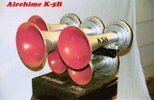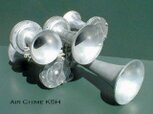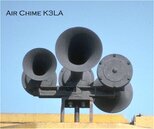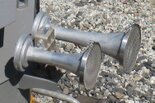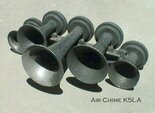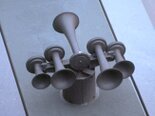BNSF RAILWAY ...im Modellbau - Horn - Nathan K-Serie
>>> AirHorn[nicht oeffentlich machen!]
A Collection of Airhorns Soundfiles - Eine Sammlung von Airhorns Soundfiles
Nathan K-Serie
Zum den Entsprechenden Sound zu Hören auf das Lautsprecher Symbol unter "Sound" Klicken!
Wer gern das eine oder andere Sound Files haben möchte kann sich bei mir Melden. Alle Soundfile sind im Format MP3/WMP/WAV. Es können mit der Zeit noch mehr Sound Files von Air Hörner hinzu gefügt werden.
Wer gern sein eigenes Sound File vom Air Horn veröffentlichen möchte auf dieser Seite. kann sich ebenfalls bei mir Melden.
Sehr lange Seite!
Nathan / AirChime - K-Serie | |||
1 | AirChrime K5H | K-5h Airchime's original five chime "K-horn", tuned in the Canadian minor chord of D#, F#, A#, C, D#. This one is on the original "high mount" manifold. | |
2 | Nathan/AirChime K-5H | A nice recording of a Canadian tuned 5 chime locomotive horn. | |
3 | AirChime K5H | The picture illustrates a common arrangement of the horn bells, with the #2 and #4 bells reversed. In this configuration, the horn is designated a K5HR24. The "H" indicates the use of a high-profile manifold. The manifold places three horn bells over two, making the horn look somewhat top-heavy compared to the two-over-three configuration used on the M5 and P5. The K5H horn bells can also be mounted on a low-profile "L" manifold to give a K5L (see the K5LA for a picture of an "L" manifold). The sound is the same. Front and rear views of an all-bells-forward K5H, courtesy Brent Lee. The K-series horns were introduced in 1954 as low-maintenance alternatives to the M-series, with a somewhat more pleasant tone than the brassy P-series. The K's were sold exclusively in Canada until the mid-1970's, when the K5's chord was modified to produce the K5LA for Amtrak. The optional "L" manifold was introduced at the same time, and horns with the older, high-profile manifold were redesignated K5H. The K5H and K5L are used primarily by BC Rail in Canada. They were extremely rare on American railroads until the mid-1980's, when railroads such as CSX, Norfolk Southern, Southern Pacific, Chicago & North Western, and New York Susquehanna & Western received the K5H on a few orders of GE locomotives. The horns on the SP and CNW GE's have largely been replaced with three-chime horns. A few K5L horns have shown up on Amtrak locomotives. Original factory tuning was: D# minor 6th (D#,F#,A#,C,D#).Later horns tend to sound more of a half major/half minor chord. Although the K5H and K5L are not common today on US railroads, they are still in common use in Canada and can still be purchased from Airchime. Airhorn from K5H and K5L sound samples: CSX Dash 8-40C and Dash 8-40CW: Sample1 (sehr kurz) | |
4 | AirChime K5H | K5H and K5L sound samples: CSX Dash 8-40C and Dash 8-40CW: Sample2 (kurz) | |
5 | K5H and K5L sound samples: CSX Dash 8-40C and Dash 8-40CW: Sample3 | ||
6 | K5H and K5L sound samples: Norfolk Southern Dash 8-32B: Sample1 | ||
7 | K5H and K5L sound samples: Norfolk Southern Dash 8-32B: Sample2 | ||
8 | K5H and K5L sound samples: Southern Pacific, various locomotives: Sample1 | ||
9 | K5H and K5L sound samples: Southern Pacific, various locomotives: Sample2 | ||
10 | When bad things happen to good horns: K5H with one bell squealing: Sample1 (kurz) | ||
11 | AirChime K5LA | K-5la Airchimes best seller, the most common horn in North America, sounding the chord of D#, F#, G#, B, D#. found on NS. CSX. Amtrak, most regional passenger lines locomotives. | |
12 | A K5LA mounted on Amtrak | ||
13 | Back in the early 90's I used to test my horns at a spot in Glenmoore, Pa. Great echo there. Here's a clip of one of my first K-5LA's which I bought from Tom Aker back in 1988 which sounds like the K-5LA's should, not the way the current crop of I don't give a hoot what it sounds like attitude of Nathan's, as long as it makes noise! | ||
14 | Nathan K-3LA | Back in 1991, on the Tioga Central, a tourist line out of Owego, NY. Which Elwood Belknap also engineered for. This day we had my K-3LA mounted on Alco RS-1 #62 as Elwood is west of Gravel Pit Road crossing doing a mighty fine job of making pretty music. Outstanding echo! | |
15 | Nathan K-5H | This one back in 1991 A New York Susquehanna & Western GE B-40-8 at Owego, NY. eastbound with its K-5h sounding off. | |
16 | Nathan K-3L | A runby of my K-3L with the odd #2 bell sounding G, rather than F#. D#, G, A#. | |
17 | A Canadian National SD-70 heading east on the Reading & Northern, Lehigh line, with freight 40t, at White Haven, Pa. The engineer put on a good audio show with the K-3L for me! | ||
18 | Nathan K-3LA | A Reading & Northern C-36-8 at Port Clinton, Pa. As it enters R&N. Engine terminal with K-3LA sounding. | |
19 | Nathan K-3L | Michael Eby's recording of a Canadian National freight equipped with a K3L. More of his information and recordings can be found here: Trainiax [geht in einem neuen Fenster auf] | |
20 | A K3L runby, mounted on a truck | ||
21 | Nathan Airchime K3L and K3H | These horns were introduced in 1954 as a low maintenance alternative to the M3H . They were a derivative of the derivative the K5H, using the #1, 2, and 3 bells from that horn to produce the D# minor chord required for use in Canada at that time. Early K3H's used the same pyramid-shaped manifold as the J3; later horns used either the high profile H manifold or the low profile L manifold. The horn pictured above is an early, sand cast K3L produced by AirChime licensee Holden Ltd. Horns produced after 1974 are die cast, and have a much smoother finish. Some K3H's cast by Holden between 1957 and 1969 came with adjustable back caps, as shown at left (note the adjustment nuts at the centers of the caps). Most K horns are not adjustable. Note also the high profile H manifold, which features a short "neck" below the middle of the manifold. An American-tuned K3LA illustrating the later die cast finish. The K3H and K3L are primarily Canadian horns, but do occasionally show up on American railroads, notably on the BNSF 960-series Dash 9-44CW's. Subsequent new BNSF locomotives have come with the American-tuned K3LA. Factory tuning is: D# minor (D#,F#,A#) The horn uses bells #1, 2, and 3 from the K5H. The K3H and K3L are the predominent horn on Canadian Pacific, Canadian National, and VIA Rail Canada. They are relatively rare on US railroads. Airhorn from BNSF 960-series Dash 9-44CW: Sample1 (sehr sehr kurz) | |
22 | AirChime K3L and K3H | BNSF 960-series Dash 9-44CW: Sample2 | |
23 | BNSF 960-series Dash 9-44CW: Sample3 (kurz) | ||
24 | CP Rail, various locomotives: Sample1 | ||
25 | VIA Rail Canada F40PH: Sample1 | ||
26 | River Terminal SW1001: Sample1 | ||
27 | AirChime K-3LA | The K3LA is one of the most common locomotive horns in service. | |
28 | Nathan K3LA / K3HA | The picture above illustrates a common arrangement of the horn bells. From left to right, the bells are #4a, 1, and 2 with the #2 bell reversed, giving a K3LAR2. This particular horn uses the low profile L manifold, ironically mounted on a raised base. Other common arrangements are all-bells-forward and with the 4a bell reversed, the K3LAR4a. Factory tuning for both the K3LA and K3HA is: B major (D#,F#,B) The K3LA and K3HA are common horns on both BNSF and Union Pacific. In recent years, they have been supplanted by the K5LLA and K5HL on new locomotive purchases from EMD and GE. The K3LA was also used on later Soo Line locomotives. Airhorn from Santa Fe, various locomotives: Sample1 | |
29 | Santa Fe, various locomotives: Sample2 | ||
30 | Santa Fe, various locomotives: Sample3 | ||
31 | Santa Fe, various locomotives: Sample4 | ||
32 | Union Pacific, various locomotives: Sample1 | ||
33 | Union Pacific, various locomotives: Sample2 | ||
34 | When bad things happen to good horns Horn with one bell silent: Sample1 | ||
35 | When bad things happen to good horns Horn with one bell silent: Sample2 | ||
36 | Horn with two bells silent: Sample1 | ||
37 | Various fouled K3LA's: Sample1 | ||
38 | Various fouled K3LA's: Sample2 | ||
39 | Various fouled K3LA's: Sample3 | ||
40 | Airchime K2H | The K2H uses K-bells 1 and 2 attached to the sides of a special narrow manifold. This particular horn is fitted with optional screens over the bells to keep debris from fouling the horn. The 1975 Nathan Airchime catalog lists the K2H as a "standard 2-tone locomotive whistle as supplied on export locomotives." Few have apparently been supplied for use on domestic US locomotives. One exception is Railpower RP20BD and RP20CD genset locomotives, some of which use a K2H mounted in front of the cab in combination with a separate KS2 mounted on the rear of the cab as shown the third photo below. Not all Railpower gensets use this arrangement; many are fitted with a single K3LA instead. The K2H plays D# and F#, a minor 3rd interval. Railpower RP20BD gensets built as RPRX lease units and RP20CD gensets built for Union Pacific are the only known US applications of the K2H. NO SAMPLE AVAILABLE! | no sound! |
41 | Other K2 horns | San Francisco Peninsula commuter railroad Caltrain originally fitted its F40PH-2 locomotives with 5-chime K5LA horns. The railroad moved the horns from the cab roof to a spot near the middle of the locomotive in the late 1990's. In 2001, bowing to noise complaints from neighborhoods near the tracks, it replaced the K5's with P2 horns as the primary horn. The railroad left the K5 manifold in place on the locomotive roof, removed the 1, 4a, and 5 bells, and reversed the 2 and 3a bells to use as a backup horn. These ersatz K2's were seldom heard until July 2009, when the bells were turned forward once again and made the primary horn, replacing the P2's. The 2 and 3a bells play F# and G#, a major 2nd interval and probably the least pleasing 2-note combination available from the five notes that comprised the K5LA. Airhorn from "Caltrain K2" sound samples: Sample1 | |
42 | "Caltrain K2" sound samples: Sample2 | ||
43 | "Caltrain K2" sound samples: Sample3 | ||
44 | "Caltrain K2" sound samples: Sample4 | ||
45 | Nathan K-5HLA | This is a most excellent sounding K horn, at least in the web master's opinion. It was played on a General Motors GP-30 during the Oak Ridge locomotive airhorn convention in September, 2004. The horn is owned by Doc Bryant. | |
46 | AirChime K5HL | The picture illustrates a common arrangement of the horn bells, with the #2 bell reversed. In this configuration, the horn would be designated a K5HLR2. The "H" indicates the use of a high-profile manifold, and the L indicates the use of the 1L bell replacing the 5 bell of the standard K5H. The US Code of Federal Regulations has long specified a minimum decibel requirement for the "audible warning device" on railroad locomotives: 96dB(A) at 100 feet forward of the locomotive in its direction of travel (49CFR229.129). Effective December 18, 2004, the regulation also began to specify a maximum volume of 110dB(A) at 100 feet. Contemporaneously, and apparently in response to this regulation, AirChime began producing 5-chime K horns for US locomotives that made use of the low-pitched 1L bell, which plays C (261Hz). K5HL horns installed on Union Pacific and BNSF GE locomotives have generally been mounted backwards, with the 3 bell facing forward and the 1L, 1, 2, and 4 bells facing the exhaust stack. This UP horn, and the one at the top of the page, wear UP's standard "shower caps" over the bells to keep foreign matter out. Intended tuning is: C,D#,F#,A#,C (261, 311, 370, 470, 512 Hz)The horn uses the K-series #1L, 1, 2, 3, and 4 bells In practice, variations in manufacturing have resulted in bells whose pitches were not on-spec. In particular, most K5HL's manufactured before the summer of 2007 have a distinctly different sound from those made later. K5HL horns began appearing on new General Electric locomotives in late 2004. Airhorn from "old" K5HL sound samples: UP and BNSF ES44AC and ES44DC: Sample1 | |
47 | "old" K5HL sound samples: UP and BNSF ES44AC and ES44DC: Sample2 | ||
48 | "old" K5HL sound samples: UP and BNSF ES44AC and ES44DC: Sample3 | ||
49 | "new" K5HL sound samples: BNSF ES44C4: Sample1 | ||
50 | "new" K5HL sound samples: BNSF ES44C4: Sample2 | ||
51 | AirChime K5LA | The picture illustrates the K5LA as it is used by Amtrak and other passenger railroads, with all bells facing forward. The horn bells are numbered from largest to smallest; from left to right in the picture, the bells are numbers 5, 3a, 1, 2, and 4a. Freight railroads generally opt for the horn with one or more bells reversed. Common arrangements include reversing the #2 and 4a bells to give a K5LAR24 or the #2 and 3a bells to give a K5LAR23. The K5LA was developed in 1975 for Amtrak at the suggestion of Deane Ellsworth. The horn was an adaptation of the AirChime K5H in which the #3 and #4 bells were modified to change the D# Minor 6th chord to B Major 6th. The "A" in the designation refers to this "American" tuning. The "L" in the designation indicates the use of a low-profile manifold, which was also developed specifically for Amtrak to meet their clearance requirements. All five horn bells are arranged in a low arc, compared to the 3-over-2 arrangement on the K5H. While there is nothing to prevent the "American" bells from being mounted on an H manifold to give a K5HA, this is rare. Amtrak did receive a few K5LA's with the horn bells spread over two separate manifolds, 2 bells on one and 3 on the other. These were used to replace the two-piece Leslie SL-4T horns on some of the later SDP40F's. The sound is the same regardless of the manifold used. Factory tuning is B major 6th: (D#, F#, G#, B, D#). The horn uses the K-series #1, 2, 3a, 4a, and 5 bells. Although it was designed for Amtrak, the first production K5LA's went to Chessie System on an order of GP40-2's. The horn is now the standard on Amtrak and numerous commuter railroads across the US. Freight carriers CSX and Norfolk Southern receive the K5LA (with reversed bells) on their new locomotives. In a somewhat surprising move, 3-chime adherant Union Pacific received K5LAR24's on one of its groups of new SD70M's delivered in 2001. The horn has also found its way onto a variety of shortlines. Airhorn from Amtrak F40PH: Sample1 | |
52 | Amtrak F40PH: Sample2 | ||
53 | Amtrak F40PH: Sample3 | ||
54 | Amtrak F40PH: Sample4 | ||
55 | Amtrak F40PH: Sample5 | ||
56 | Amtrak F69PH-AC: Sample1 | ||
57 | Amtrak Dash 8-32BWH: Sample1 | ||
58 | Amtrak P42DC: Sample1 | ||
59 | CalTrain F40PH-2 and cab car: Sample1 (kurz) | ||
60 | CalTrain F40PH-2 and cab car: Sample2 (kurz) | ||
61 | CalTrain F40PH-2 and cab car: Sample3 (kurz) | ||
62 | In response to complaints that the K5LA horn is too loud, some roads like CSX use the horns with restrictors or "choke fittings" installed. These cut down the supply of air to the horns and reduce the decibel level. The character of the horn is also changed, as these samples illustrate: CSX, various locomotives: Sample1 | ||
63 | CSX, various locomotives: Sample2 | ||
64 | CSX, various locomotives: Sample3 | ||
65 | CSX, various locomotives: Sample4 | ||
66 | Hybrids Some K5LA horns have come from Nathan with standard #3 bells instead of #3a's. The resulting sound is sort of half-way between a K5L and a K5LA. Horns like this can be found on some Amtrak and Norfolk Southern locomotives. Amtrak P42DC: Sample1 | ||
67 | Amtrak P42DC: Sample2 | ||
68 | Amtrak P42DC: Sample3 | ||
69 | Amtrak P42DC: Sample4 | ||
70 | Amtrak P42DC: Sample5 | ||
71 | When bad things happen to good horns: K-series horns are generally fairly durable, but under adverse circumstances, even they can "go bad." In the 1990's, in the interest of reducing the noise level in the locomotive cab, Amtrak began relocating the airhorns on their F40PH locomotives from a notch in the cab roof to a position between the exhaust stack and the dynamic brake fan (click for photo (geht ein neues Fenster auf)). Unfortunately, this is one of the hottest locations on the outside of the locomotive, and the horns are subjected to a constant diet of diesel exhaust. Over time, as a result of the heat and smoke, they develop a rather peculiar sound as bells start overblowing or "squealing," or stop sounding altogether. This is illustrated in the following samples. San Francisco Bay Area commuter railroad Caltrain had the horns similarly relocated on their F40PH's in the late 1990's, with similar results. Airhorn from Amtrak F40PH's with "smoker's horns": Sample1 | ||
72 | Amtrak F40PH's with "smoker's horns": Sample2 | ||
73 | Amtrak F40PH's with "smoker's horns": Sample3 | ||
74 | Amtrak F40PH's with "smoker's horns": Sample4 (sehr kurz) | ||
75 | Amtrak F40PH's with "smoker's horns": Sample5 | ||
76 | Caltrain F40PH's with "smoker's horns": Sample1 | ||
77 | AirChime K5LLA | The picture illustrates a common arrangement of the horn bells, with the 1L bell reversed. In this configuration, the horn would be designated a K5LLAR1L. The first "L" indicates the use of a low-profile manifold, the second "L" indicates the use of the low pitched 1L bell replacing the 5 bell of the standard K5LA. As with the K5HL, the K5LLA began appearing on US railroads in 2004, apparently in response to a change in the US Code of Federal Regulations (49CFR229.129) that specified a maximum as well as a minimum decibel requirement. The combination of notes is a dischord, even when all bells are machined to their proper fundamental frequencies. Intended tuning is: C,D#,F#,G#,B (261, 311, 370, 415, 494 Hz) The horn uses the K-series #1L, 1, 2, 3A, and 4A bells In practice, variations in manufacturing often result in bells whose pitches are not on-spec. K5LLA horns began appearing on new EMD locomotives in late 2004. Airhorn from UP SD70ACe: Sample1 (sehr kurz) | |
78 | UP SD70ACe: Sample2 | ||
79 | UP SD70ACe: Sample3 | ||
80 | UP SD70ACe: Sample4 | ||
81 | Courtesy Tom Hallendorf: Sample1 | ||
82 | Courtesy Tom Hallendorf: Sample2 | ||
83 | Nathan K-5LA | A very good recording of a K5LA equipped CSX freight | |
84 | K5LA blown on a standard compressor, with some echos | ||
85 | This is Ken Kanne's speeder car equipped with a K5LA. | ||
86 | Metra 416 running a K5LA in Chicago, Illinois by Texas Eagle | ||
87 | SKOL local approaching one of six gate guarded crossings at 12:05 AM Wed. morn., Wichita, Ks. This the best recording of a K5LA that I have heard so far! By Ron Chamberlain | ||
Wer den einen oder anderen Sound gerne möchte kann sich bei Mir Melden. Alle Soundfile sind im Format MP3/WMP.
Es werden mit der Zeit noch mehr Sound Files von Air Hörner hinzu gefügt.
Alles welches Orange Hinterlegt ist. War das Horn, welches die BNSF benutzt/benutzte.
Alle Bilder, Sounds und Texte (english) auf dieser Seite sind von dieser Seite: http://www.dieselairhorns.com/ und dieser Seite: http://atsf.railfan.net/airhorns/index.html
Wer gern möchte das sein eigener Sound von US-Railroad auf dieser Webseite zuhören ist. Kann sich auch bei mir Melden. Beim veröffentlichen auf dieser Webseite wird beim entsprechenden Soundfile sein Copyright angebracht oder darauf verwiesen.
Melden und Anfragen bezüglich Soundfiles oder Veröffentlichen - Bitte HIER.





